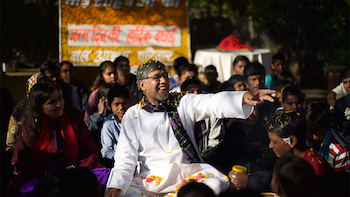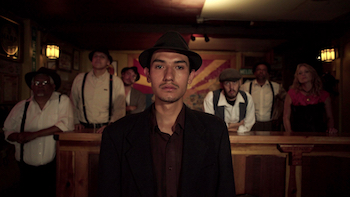For all its reputation of glitz, glamour, and celebrity sightings, Sundance still has a place for folks like us on its red carpet. I returned to the hallowed film festival last month for the first time since The Movement played there in 2012. It was high-octane fuel for my creative engines. “Why haven’t I done this sooner?” I asked myself.
To be fair, it’s a tough festival for filmmakers strapped for money and time. Several things made it possible this year: former Warren Miller road crew stud, Dave Studdert, and his family kindly hosted us for the first weekend. Kevin Kerndt, Power of the River‘s titles and motion designer, provided the car and most of the driving that weekend. Our composer Stefan Smulovitz booked his flights and somehow crowbarred in a four-day break from his intense work schedule to join us. The second weekend, AirB&B hosts Kristopher and Katrina offered me and Kim a room for peanuts.  Kim kindly tolerated my eagerness to see three back-to-back films in one day— and then gracefully declined when I tried to shoehorn in a fourth show (she was right: we needed time to process). And the Sundance Institute kicked it all off by offering me a free alumni credential— and some perks as a supporting member that helped us get tickets to the shows we’d most hoped to see. Just the push I needed.
Kim kindly tolerated my eagerness to see three back-to-back films in one day— and then gracefully declined when I tried to shoehorn in a fourth show (she was right: we needed time to process). And the Sundance Institute kicked it all off by offering me a free alumni credential— and some perks as a supporting member that helped us get tickets to the shows we’d most hoped to see. Just the push I needed.
In the end I saw eight feature films, eleven shorts, and took part in one powerful virtual reality small-group experience (called ‘VR_I’ – check out this 3-minute teaser). We caught a couple parties, had a meeting with the team behind Sundance’s Creative Distribution Initiative (I’m in competition for their CDI Fellowship this year: please send me good juju!), and soaked in the general vibe of the flagship event of the Sundance brand.
Flagship event? To listen to Bob Redford talk about it, Sundance is less about the fest and more about its labs, its direct support of independent artists who tell stories from underrepresented perspectives. I’ve noticed in recent years that support seems to be accelerating, filling in holes that may actually empower me and my fellow indie storytellers in the early stages of the process (rather than picking at the leftovers after filmmakers have taken all the risk and invested all the effort to get a film finished). I’m most excited about initiatives like Sundance’s CDI, their Creative Producing Fellowship, and the Discovery Impact Fellowship which led, in part, to Jeff Orlowski’s new film: the gorgeous and powerful Chasing Coral.

Several of the films we saw this year had a common thread that was apparent to me: Audience engagement that starts right in your theater seat. Kailash could have been a simple celebratory biopic about a hero who has dedicated his life to freeing child slaves in India. But instead it swept the audience along through the dramatic, breathless action of a factory raid— in the style of The Cove. It balanced this intense drama with uplifting scenes from the raids’ aftermath: rescued children being given a second chance at the innocence and joy all children should have the opportunity to enjoy. This uplift was tempered by concerns that some of these kids might get sucked back into the same vexing cycle that put them in the factories in the first place. And then the ultimate audience engagement: a finger pointing back at our packed theatre audience there in downtown Salt Lake City, emphasizing that just one of the U.N. member nations has not ratified its Convention on the Rights of the Child: The U.S.A. There was a collective groan from the audience as we realized that our own country is not off the hook— and is almost certainly complicit. Kailash Satyarthi himself, and the momentum he’s building with his life’s work, stands out as compelling reason for hope. It was amazing to trace that rollercoaster of emotions through one single film. The standing ovation, as this Nobel Peace Prize recipient himself came on stage, was perhaps the longest I’ve ever witnessed at a film screening.

Engaging an audience in a documentary from just about the very first shot has become a hallmark of Robert Greene films. His new offering Bisbee ’17 follows in the footsteps of his brilliantly challenging Kate Plays Christine. Both films grapple with a sordid legacy from the past and its impact on present society. In the director’s commentary for Kate, Greene admits to consciously aiming to frustrate audiences. Odd choice for a storyteller, right? Breaking multiple conventions of the form, he includes actors in his documentaries, he creates deliberately flawed historical recreations, and he acknowledges his film crew’s intrusion into the story he’s telling— all wonderful deconstructions of the boundaries between observer and subject, between slick storytelling and unvarnished reality. Somewhere in the middle is the truth that Greene seeks— and the effort always galvanizes lively conversation.

For me, this year’s best example of a filmmaker engaging the audience was the surprising A Woman Captured. Filmmaker Bernadett Tuza-Ritter spent an agonizing series of months in claustrophobically close quarters, filming her subject Marish who is essentially a modern-day domestic slave. Ultimately the filmmaker can’t resist intervening, offering assistance to Marish in her escape. An emotional hug between subject and observer, as the camera continues rolling, brings us all together into one big group hug of solidarity. I thank Marish (a.k.a. Edith) willing to trust the filmmaker; and I thank Tuza-Ritter who acknowledged her own empathy and humanity over myths of “journalistic objectivity” and “distance from the subject.” It was a compelling example of film bringing us together.
Each in their own way, these films are true independents. I’m honored to be an alum of the Sundance organization and excited that it continues to support art that challenges conventions, breaks taboos, and moves audiences in meaningful directions.
Thanks for reading!
Cheers,
![]()